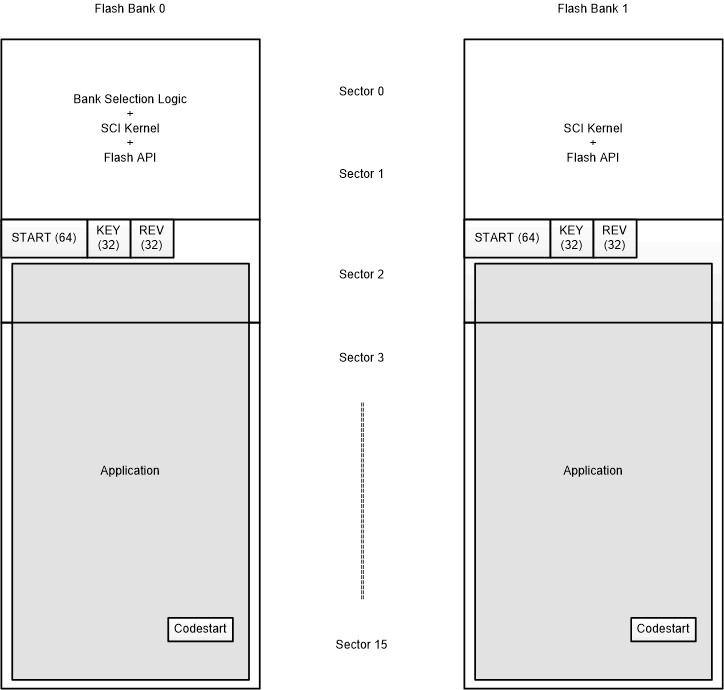-
Live Firmware Update With Device Reset on C2000 MCUs SPRUIU8A March 2020 – August 2021 TMS320F280040-Q1 , TMS320F280040C-Q1 , TMS320F280041 , TMS320F280041-Q1 , TMS320F280041C , TMS320F280041C-Q1 , TMS320F280045 , TMS320F280048-Q1 , TMS320F280048C-Q1 , TMS320F280049 , TMS320F280049-Q1 , TMS320F280049C , TMS320F280049C-Q1
-
Live Firmware Update With Device Reset on C2000 MCUs
Live Firmware Update With Device Reset on C2000 MCUs
Trademarks
C2000, Code Composer Studio, are trademarks of Texas Instruments.
All trademarks are the property of their respective owners.
1 Introduction
In applications like server power supply, metering, and so forth. the system is desired to be run continuously to reduce downtime. But typically during firmware upgrades due to bug fixes, new features, and/or performance improvements, the system is removed from service causing downtime for associated entities as well. This can be handled with redundant modules but with increase in total system cost. An alternate approach, called Live Firmware Update (LFU), allows firmware to be updated while the system is still operating. Switching to new firmware can be done either with or without resetting the device, with the latter being more complex.
2 Resources Required for LFU
LFU is feasible when the device has enough resources of various kinds – CPU bandwidth, Memory, and Peripheral availability:
- CPU Bandwidth – The new firmware has to be transferred using a communication peripheral and written to flash memory while the application is still operating. This means CPU need to have enough available bandwidth to support LFU.
- Memory – The non-volatile memory that is used here is Flash
memory. Flash read and write operations cannot be simultaneously performed on
the same Flash bank. However read and write operations can be simultaneously
performed on different Flash banks. Hence, the ideal scenario is for the device
to contain dual Flash banks. In devices with single Flash banks, LFU is
particularly challenging, but still feasible provided:
- The complete application code (or a portion of it that controls the output(s) the user is interested in) and Flash APIs need to run from RAM memory while the new firmware is updated to Flash. This means there should be enough RAM memory that can be utilized.
- Some devices support Flash APIs in ROM; in those devices the application code can run from RAM and Flash APIs can run from ROM memory, thus reducing the RAM requirement.
- Peripheral Availability – A spare communication peripheral using the new image can be transferred from the host to the device.
LFU is easier to implement in devices with multiple Flash banks. In this document and the reference example, it is assumed that the device has 2 Flash banks. The device considered is TMS320F28004x, which has dual flash banks. Their address space is 64K x 16 each, with addresses ranging from 0x80000-0x8FFFF, and 0x90000-0x9FFFF.
3 Memory Layout
The Flash memory has been partitioned as shown in Figure 3-1.
 Figure 3-1 Flash Memory Contents for Bank 0 and Bank 1
Figure 3-1 Flash Memory Contents for Bank 0 and Bank 1Assuming each Flash bank has 16 sectors, two sectors have been allocated to Static code (code that will not change between applications). This is described in Section 4.
A few locations in sector 2 have been reserved to store the below entries:
- START – when this 64-bit field is set in a specific Flash bank (to 0x5A5A5A5A5A5A5A5A) by the Serial Communications Interface (SCI) Flash Kernel, it indicates that the corresponding Flash bank has been erased (Application sectors) and programming/verification is about to begin. In this example, the START field is located at addresses 0x82000 in BANK0 and 0x92000 in BANK1.
- REV – this represents a 32-bit Firmware revision number that is set by the SCI Flash Kernel which is used by the Bank Selection Logic to determine which the latest image is between Flash bank 0 and 1. REV starts at 0xFFFFFFFF and is decremented on each subsequent Flash programming cycle. Thus, the Bank with the lower revision number is considered the latest one. Firmware revision field is handled by the flash kernel for simplicity. In practice, the last downloaded image may not be the latest firmware version and the application image would contain the firmware version, but that assumption is made with this model where the kernel updates the REV field. In this example, the REV field is located at address 0x82006 in BANK0 and 0x92006 in BANK1. As an example, if the REV in BANK0 is FFFF FFFA, and the REV in BANK1 is FFFF FFF9, BANK1 will be considered the latest firmware and will execute.
- KEY– The image in a bank is considered as valid if this location contains a valid KEY (0x5B5B5B5B). This Key is written to by the SCI Flash Kernel, and is read and tested by the Bank Selection Logic. In this example, the KEY field is located at addresses 0x82004 in BANK0 and 0x92004 in BANK1.
The rest of sector 2 and sectors 3-15 can be used to store the application image. This allows the static code in sectors 0 and 1 to be programmed once, and remain unchanged during LFU.